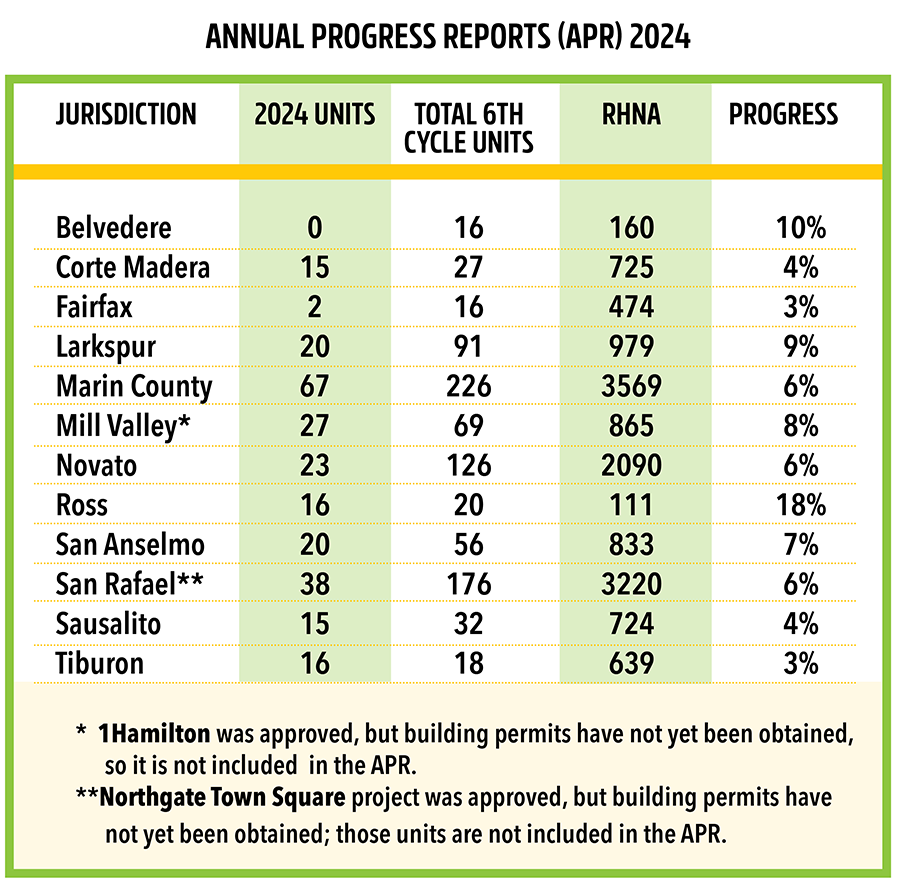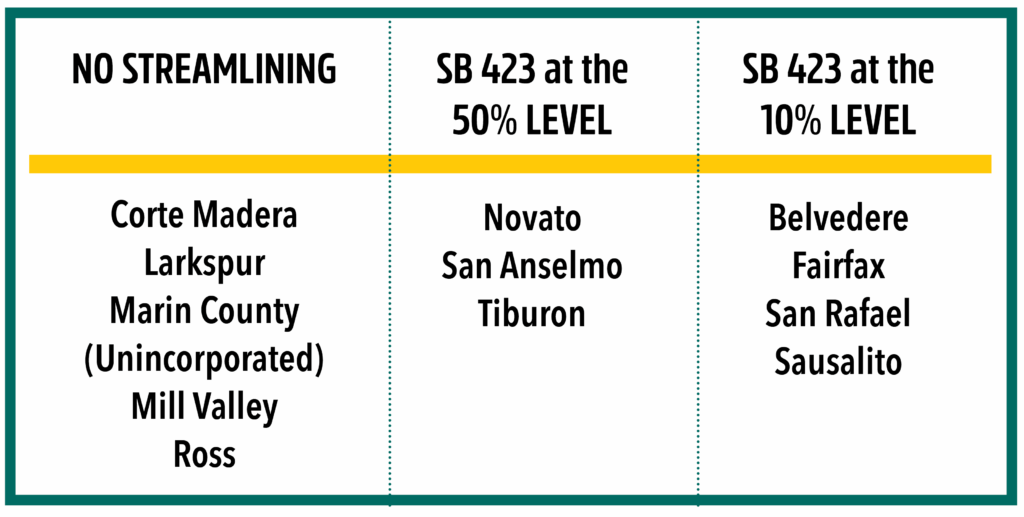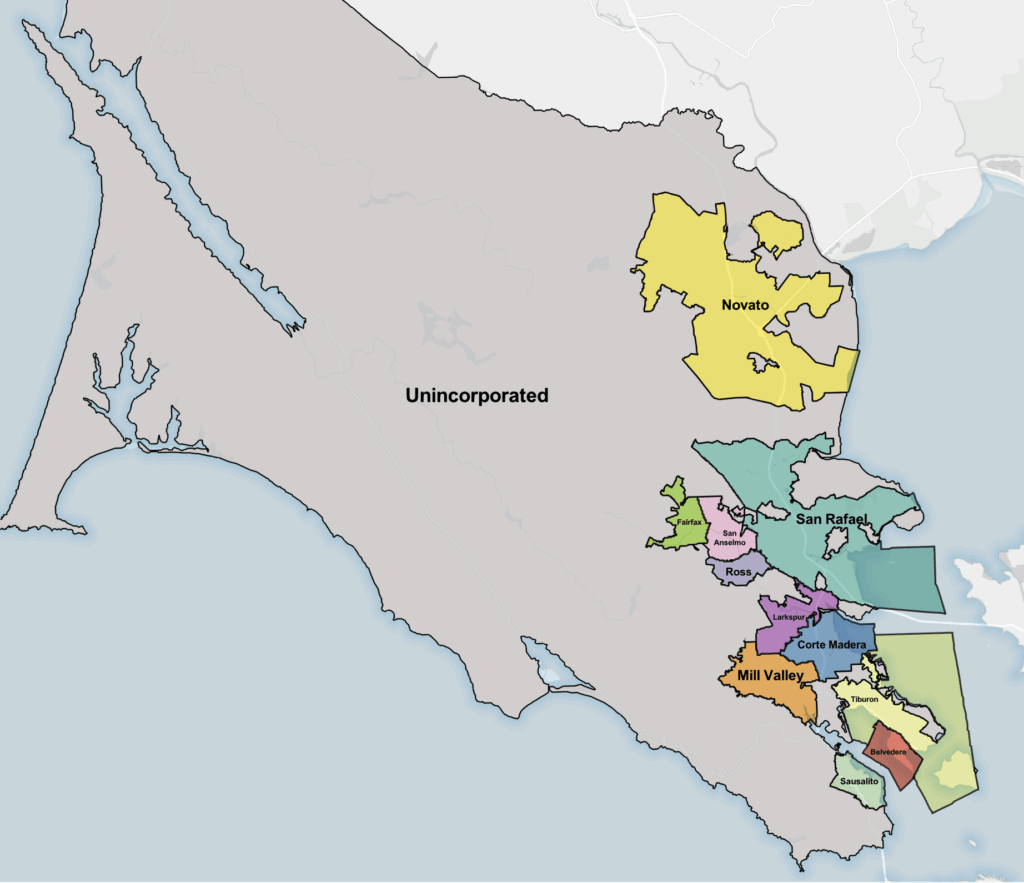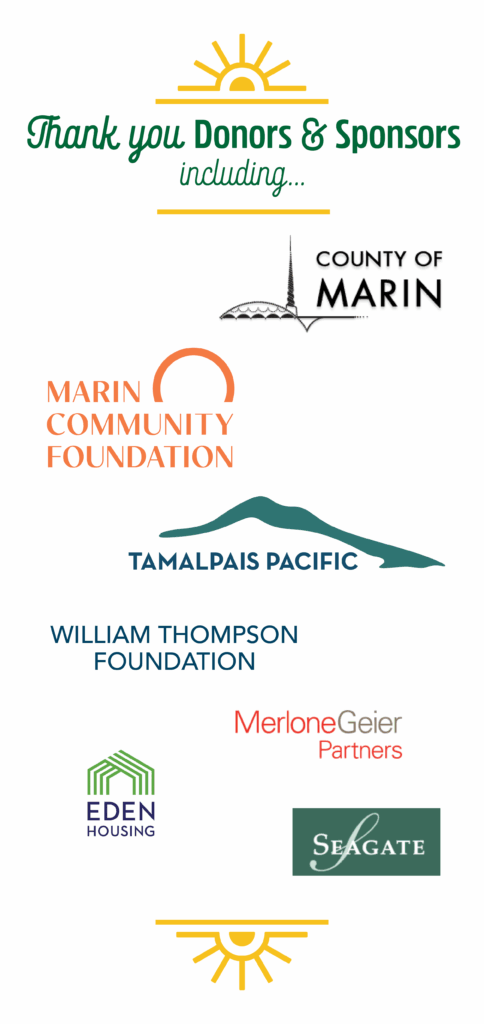Marin Housing Elements Annual Progress Report Update
We are woefully behind on progress toward our housing goals
Marin’s sixth 8-year Housing Element Cycle officially kicked off January 31, 2024. Every April, the county and each local city and town must publish an Annual Progress Report (APR) documenting progress toward achieving assigned housing goals (“RHNA,” or Regional Housing Needs Allocation). Marin, as a whole, must permit 14,404 new housing units during this cycle.
We are 2 years into our current Housing Element cycle. To be on track, each jurisdiction should be about 25% towards reaching its RHNA goal. We are way behind. Although several large projects were approved in 2024, such as the Northgate Mall Town Square, they will not appear in the APR data until building permits are issued — which could take years. Overall to date, Marin has only permitted 825 units of the required 14,404. This does not include Belvedere or Sausalito, they did not submit their APRs by the deadline and therefore their data is not included in our table. This IJ article describes Sausalito’s current fractious status: facing a special election. Both Sausalito’s and Belvedere’s Housing Elements are out of compliance.

Click links below to view each jurisdiction’s submittal. Belvedere is not included, as we did not receive a copy of their APR from city staff, and they submitted after the April 1 deadline.
Corte Madera
Fairfax
Larkspur
Marin County
Mill Valley
Novato
Ross
San Anselmo
San Rafael
Sausalito* Submitted after the April 1 deadline
Tiburon
There are consequences for not meeting goals and deadlines
There are consequences for not meeting housing element goals and deadlines, including ineligibility for funding sources and potential fines. The two most feared consequences are streamlining under SB 423, which specifies a number of rules in order to bypass many of the procedural requirements for obtaining a permit (“streamlining” approval); and the Builder’s Remedy, SB 423. This law provides two levels of streamlining, depending on a jurisdiction’s level of compliance with housing element law. For minor non-compliance, jurisdictions only need to apply streamlining criteria to housing projects with at least 50% affordable housing units (“the 50% level”). At a greater level of non-compliance, jurisdictions need to apply streamlining to housing projects with at least 10% affordable housing units (“the 10% level”). The 10% level is more commonly financially achievable for more development projects. (See more here).
Builder’s remedy allows developers to bypass local zoning and general plan standards. Historically, the Builder’s Remedy has rarely been used, but the State of California revised the law this year to make it easier for developers to benefit from the remedy.
What triggers streamlining

- Missing the April 1st APR deadline. SB423 at the 10% level will be applied.
Belvedere and Sausalito fall into this category. - Noncompliant housing elements. SB423 at the 10% level and Builder’s Remedy applies. Belvedere and Sausalito appear to fall in this category.
- Falling short of the RHNA numbers (not permitting sufficient housing). HCD determines progress towards RHNA numbers every four years: at the half-way point and end of each housing element cycle. The next determination will be made after the 2026 APR reports are submitted, and will be published in June 2027.
- Jurisdictions that don’t issue enough permits for affordable housing are subject to SB423 streamlining at the 50% level.
- Jurisdictions that don’t issue enough permits for housing overall are subject to SB423 streamlining at the 10% level.
Housing element implementation is more than just numbers
While RHNA housing goals garner the most attention, each jurisdiction’s Housing Element covers much more than housing production. Housing Elements must also:
- Plan for the preservation of existing affordable housing
- Prevent displacement
- Meet “Affirmatively Furthering Fair Housing” goals

Every city, town, and the county has specified a list of programs it will implement before the end of the Housing Element cycle (2032 for the current cycle), and its APR must report the progress every year. In 2024, many jurisdictions had implemented Objective Design and Development Standards (ODDS) in their elements, as well as programs to rezone areas to allow development on Housing Element sites. You can view these programs in more detail in the tables provided by each jurisdiction’s APR.
Sausalito is far behind in program implementation. One of its key programs, a voter initiative to approve rezoning, is behind schedule. As a result, Sausalito probably can’t meet its rezoning deadline. Additionally, Sausalito has been unable to implement its ODDS program. The City is trying to include view preservation and historical district standards. No other jurisdiction has implemented objective view standards, and HCD has questioned the feasibility of Sausalito’s approach.
What can we do now to support housing?
In the recent County survey, housing is the #1 issue that Marinites want our local government to address. Nonetheless, local elected decision makers hear from opponents to affordable housing development much more frequently and vociferously than from advocates. As a counterweight, it is important to tell your City Council members and Marin County Board Supervisors that you support building more housing in Marin and preventing displacement of current residents. Showing up in person at public meetings, online, or submitting public comments via email lends even more support for individual projects or policies. You can use our weekly Coming Up email (sign up here) and website as resources, as we flag important upcoming meetings and provide talking points. It is a tough environment to produce affordable housing, and it’s becoming worse due to political and financial uncertainty. Even so, the newly-enacted housing laws are making a difference, and there are a number of projects actively advancing in Marin.
Marinites understand that the housing crisis impacts their daily lives … from constrained availability of medical and health services, retail help, food service and other service support, traffic congestion, and the inability of kids, families, and long-time community members to remain or make homes in Marin… all of which further breaks down our social bonds when we most need each other. We have an opportunity to shift this unfortunate reality. MEHC provides information for strategic advocacy through our website, this monthly Perspective newsletter, and our weekly Coming Up in Housing e-letter. Join us and your friends and neighbors in helping make Marin better for everyone.
MEHC provides information for strategic advocacy through our website, monthly Perspective newsletter (archive here), and our weekly Coming Up in Housing e-letter. Join us and your friends and neighbors in helping make Marin better for everyone.

You can be a part of MEHC’s important work by reading & sharing our monthly PERSPECTIVE newsletters, joining our weekly COMING UP IN HOUSING email list (signup here>>), participating in our advocacy campaigns, and also, if you can, by donating >> to help defray our expenses. Thank you.

